This week we discuss the rare but life-threatening methemoglobinemia with a focus on recognition and use of the antidote.
Episode 97.0 – Methemoglobinemia
Show Notes
Take Home Points
- MetHb –emia occurs as a results of various medications including amyl nitrite, dapsone, nitroprusside, phenazopyridine, sodium nitrite and topical anesthetics like benzocaine
- Patients will present with cyanosis, short of breath, fatigue, dizziness, weakness and ultimately CNS depression and death at higher concentrations.
- If you have a cyanotic/hypoxic patient that does not respond to supplemental oxygen, be concerned for MetHb and send a co-oximetry panel.
- If the level is <25% and the patient is asymptomatic you can observe, but if the level is >25% or the patient is symptomatic, you will treat with the antidote methylene blue given as a bolus of 1-2 mg/kg over 5 minutes
- And as always, make sure to call your local poison center to get your toxicologists involved. They can help with dosing, and they are also an important player of the public health component in cases such as these, to make sure this is an isolated incident and we don’t have a repeat of the 11 blue men situation.
Price DP. Chapter 127. Methemoglobin Inducers. In: Nelson LS, Lewin NA, Howland M, Hoffman RS, Goldfrank LR, Flomenbaum NE. eds. Goldfrank’s Toxicologic Emergencies, 9e New York, NY: McGraw-Hill; 2011. Accessed April 19, 2017.

Methemoglobinemia Signs and Symptoms

Methemoglobinemia Treatment



Hi Core EM! Could you do a podcast on snake poisoning. I love your channel. It’s the best available on emergency medicine topics.
Sang – thanks for listening. We’ll get on that for sure.